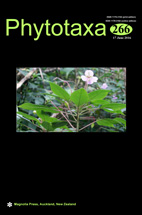Abstract
Extensive field surveys of the Critically Endangered Central and Eastern Rûens Shale Renosterveld have uncovered that Notobubon striatum, as currently circumscribed, comprises two distinct species. Upon careful examination of the type material it has become clear that names exist for both species. The type specimen of N. striatum clearly matches the lesser known species, a large shrub, ca. 1 m. tall, with a powerful anise-scent and which is restricted to the banks of seasonal rivers and watercourses in the Central and Eastern Rûens Shale Renosterveld. The second and better known entity, with a wider distribution, corresponds to the type material of Dregea collina Ecklon & Zeyher. As such, a new combination, Notobubon collinum (Ecklon & Zeyher) Magee, is here made to accommodate this taxon, restricted to dry quartz and silcrete patches or outcrops in Eastern Rûens Shale Renosterveld. In their revised circumscriptions N. striatum and N. collinum are readily distinguished by habit, scent, leaf size and division, as well as leaf lobe shape and sepal size. Comprehensive descriptions of both species are provided, together with notes on their ecology and conservation status, and the existing key to the species of Notobubon updated. This brings the number of recognised species in the genus to thirteen.

